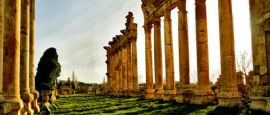Lebanon Weather, climate and geography
Weather & climate
Lebanon has a typically Mediterranean climate. There are four distinct seasons. Summer (June to September) is hot on the coast and cooler in the mountains. Spring and autumn are warm and pleasant and are the ideal times to visit for sightseeing. Winter (December to mid March) is mostly rainy, with snow in the mountains so this is the ideal time to visit to enjoy winter sports, but at lower altitudes sightseeing can be hindered by heavy rainfall.
Geography
Lebanon lies to the east of the Mediterranean, sharing borders to the north and east with the Syrian Arab Republic, and to the south with Israel/Palestinian Territory. The country possesses four distinct zones from west to east including the coastal plain, the Mount Lebanon Range, the Bekaa Valley and the Anti Lebanon range that forms its border with Syria. Lebanon is a mountainous country with approximately half of its landscape lying at an altitude of over 900m (3,000ft). For its relatively diminutive size, Lebanon offers a surprisingly diverse landscape from the fertile Bekaa Valley to the snow capped peaks of the Anti Lebanon and cedar forests of Mount Lebanon. The famous cedar trees grow high in the mountains, while the lower slopes are cultivated with grapes, apricots, plums, peaches, figs, olives and barley, often on terraces painstakingly cut out from the mountainsides. On the coastal plain, citrus fruit, bananas and vegetables are also grown.
Do you have any Feedback about this page?
© 2026 Columbus Travel Media Ltd. All rights reserved. No part of this site may be reproduced without our written permission, click here for information on Columbus Content Solutions.




 You know where
You know where